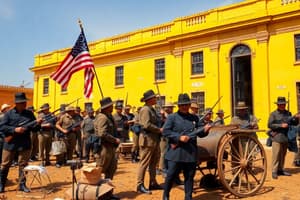Podcast
Questions and Answers
What was the Spanish American War?
What was the Spanish American War?
- A civil war within Spain
- A war fought between the US and Spain in Cuba and the Philippines (correct)
- A conflict over trade routes
- A war for Texas independence
What is yellow journalism?
What is yellow journalism?
Journalism that exploits, distorts, or exaggerates the news to create sensations and attract readers.
Who was Joseph Pulitzer?
Who was Joseph Pulitzer?
A newspaper rival of Hearst who also used yellow journalism.
Who was William Randolph Hearst?
Who was William Randolph Hearst?
What was the Teller Amendment?
What was the Teller Amendment?
What did the Treaty of Paris (1898) accomplish?
What did the Treaty of Paris (1898) accomplish?
What was the Platt Amendment?
What was the Platt Amendment?
What is Guantanamo Bay?
What is Guantanamo Bay?
What was the Foraker Act (1900)?
What was the Foraker Act (1900)?
What did the Jones Act (1917) grant to Puerto Ricans?
What did the Jones Act (1917) grant to Puerto Ricans?
Who was Emilio Aguinaldo?
Who was Emilio Aguinaldo?
What was the Philippine-American War?
What was the Philippine-American War?
What did the Jones Act (1916) promise to the Philippines?
What did the Jones Act (1916) promise to the Philippines?
What were the insular cases?
What were the insular cases?
Flashcards are hidden until you start studying
Study Notes
Spanish-American War
- Occurred in 1898 between the US and Spain, primarily in Cuba and the Philippines.
- Lasted less than 3 months; resulted in Cuba's claimed "independence" and US annexation of Puerto Rico, Guam, and the Philippines.
- Sparked by yellow journalism influenced by the sinking of the USS Maine.
Yellow Journalism
- Exploitative journalism that distorts, exaggerates, and sensationalizes news to attract readers and create public interest.
Key Figures
- Joseph Pulitzer: Rival of Hearst who employed yellow journalism techniques to boost his New York newspaper circulation.
- William Randolph Hearst: Notable capitalist in journalism and promoter of sensationalist news through The New York Journal.
Legislative Developments
- Teller Amendment: Assured the US would not annex Cuba post-war against Spain.
- Treaty of Paris (1898): Signed on December 10, officially ending the war; allowed US military presence in Cuba and annexation of territories.
- Platt Amendment: Restricted Cuban sovereignty, allowing US intervention in Cuban affairs, resulting in limited independence for Cuba.
- Foraker Act (1900): Provided Puerto Ricans with limited self-governance.
- Jones Act (1917): Granted US citizenship to Puerto Ricans and the ability to elect their legislature.
Philippine Context
- Emilio Aguinaldo: Key leader of the Filipino independence movement who declared independence in 1899 but was later captured by the US.
- Philippine-American War (1899-1902): Continuation of the independence struggle that turned into a brutal guerrilla conflict, ultimately leading to US victory.
- Jones Act (1916): Provided the Philippines with territorial status and promised eventual independence based on stable governance.
Insular Cases
- Supreme Court decisions regarding the rights of recently annexed territories; concluded that constitutional rights did not automatically extend to Puerto Ricans and Filipinos.
Studying That Suits You
Use AI to generate personalized quizzes and flashcards to suit your learning preferences.




